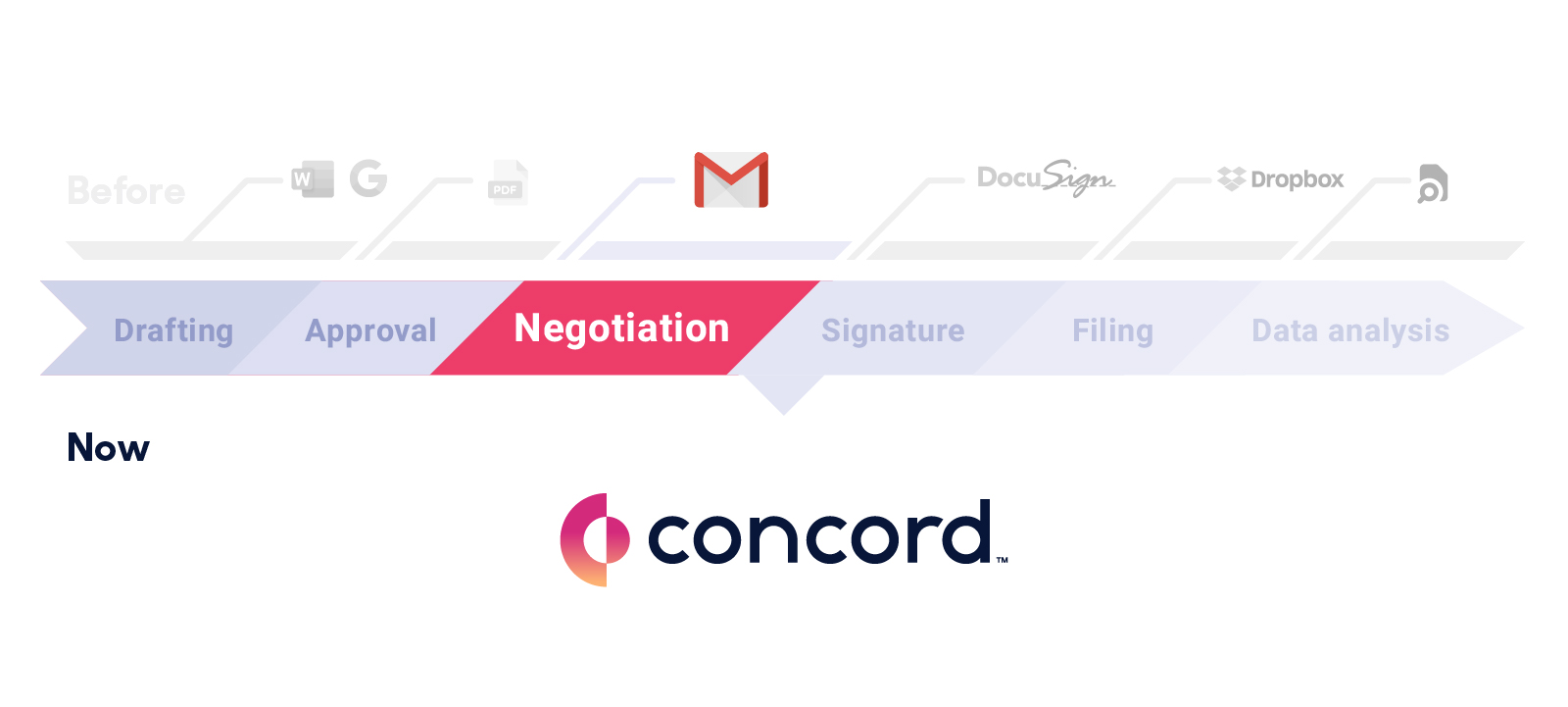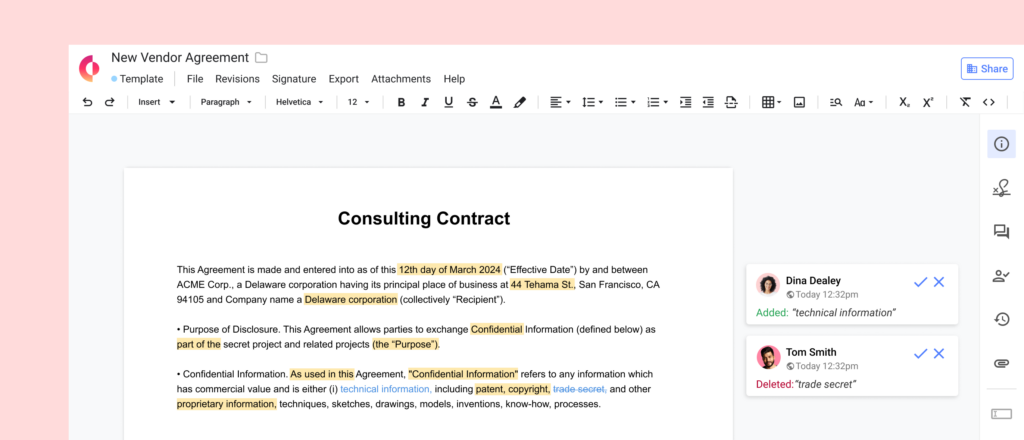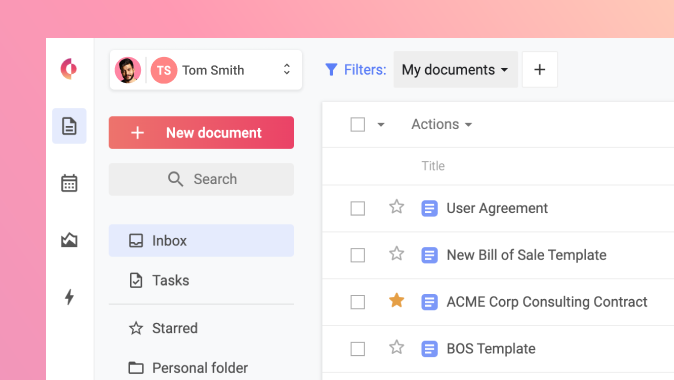Redlining a Contract: The Complete Guide
Table of contents
- What is redlining a contract?
- How the contract redline process works
- Who helps to redline contracts?
- Tips for success in contract redlines
- Do’s and don’ts in contract redlines
- How to redline a contract
- Redlining a contract step by step
- Helpful contract redline tools
- Simplifying the redlining process
-
About Concord
Effortless contract management, from drafting to e-signing and beyond. Book a live demo to see Concord in action.
Request demo
If you’ve ever had a bad experience trying to redline a contract, you might prefer to steer clear of the process altogether. Yet avoiding this step isn’t an option with many business contracts.
So let’s look at how to redline contract details efficiently. Or at the very least, how to avoid endless rounds of versions, and discussions!
What is redlining a contract?
Redlining a contract means reviewing and suggesting changes to a draft. Redlines in a contract are the visible marks indicating these proposed edits, comments, or suggestions. This process allows all parties to negotiate terms and clarify intentions before finalizing the agreement.
When you redline a contract, you’re making sure each clause receives careful consideration — fostering a transparent and collaborative contract negotiation.
Contract negotiation and contract redlining are the third stage of the contract lifecycle.
 Here are all the contract lifecycle stages:
Here are all the contract lifecycle stages:
- Drafting a Contract
- Internal Approval of the Agreement
- Contract Negotiation
- Signing the Contract
- Securely Storing the Agreement
- Tracking Contracts and Documents
The redlining and contract negotiation process falls just after the contract drafting phase and the internal approval workflow. After negotiation, you’ll manage the contract through signature, contract storage, and lastly, through tracking deadlines and contract renewals.
How the contract redline process works
Understanding how the contract redline process works can make your negotiations smoother and more effective. Here’s what typically happens.
1. Review the initial draft
The process starts when you receive the initial contract draft. One party has prepared this draft, setting out the proposed terms and conditions.
2. Propose changes
You then go through the draft and mark up any changes you suggest. These redlines might include additions, deletions, or modifications to the contract’s terms.
3. Negotiate and revise
Following your proposed changes, you and the other party engage in a discussion. This stage involves exchanging ideas and finding common ground on the contract’s terms.
4. Update the draft
After agreeing on the changes, one party incorporates these into the draft. This step results in a revised version of the contract that reflects the agreed-upon changes.
5. Final review and signing
Both parties then carry out a final review of the updated contract. You check that it accurately reflects all the negotiated terms. If everything is in order, both parties sign the contract, making it official.
This process aims to create a contract that meets the needs and expectations of everyone involved.
Who helps to redline contracts?
The Contract Drafter
The person who draws up a contract is typically either your attorney, a contract manager, a business owner, a project manager, or the person responsible for landing the deal. This is the main editor, alongside Legal. This person should be responsible for editing grammar, and assuring the terms are agreed to and correct.
Legal
Legal should only be responsible for reviewing whether the contract is enforceable, and revising any terms that are not legally viable. They are crucial to the contract redline process.
Decision Makers
The executive team, business owners, or department leads can all be decision-makers in the process. Determine who has final decision-making abilities first. This is a crucial step to making negotiations smoother and faster.
Stakeholders
Stakeholders include everyone listed above, as well as team experts, such as procurement analysts, financial analysts, or researchers.
The most important aspect is how you manage the workflow between these parties. The process should be clear, and allow enough room for all parties to offer feedback.
Additionally, always communicate the expected time commitments for each party to provide revisions.
Tips for success in contract redlines
Successfully redlining contracts requires a strategic approach. Here are some tips to help you navigate this process effectively.
Understand the original document
Before you start redlining, fully understand the original contract. Know what each clause means and how it impacts the agreement. This knowledge guides your redlining decisions.
Communicate clearly and concisely
When you propose changes, make your language clear and direct. Avoid ambiguity to prevent misunderstandings and make your intentions clear.
Prioritize key changes
Focus on the most important changes first. Not all parts of the contract will require revisions, so prioritize the ones that significantly impact the agreement.
Seek mutual benefit
Aim for changes that benefit both parties. This approach promotes a more collaborative and positive negotiation atmosphere.
Stay organized
Keep track of all changes and versions of the contract. An organized approach helps prevent confusion and helps make sure you don’t overlook any important details.
Be open to compromise
Sometimes, you’ll need to compromise. Be open to alternative solutions that still align with your key objectives.
Review and double-check
Before finalizing, thoroughly review the redlined contract. Double-check that all changes accurately reflect the agreed-upon terms.
Following these tips can make the redlining process more efficient and effective, leading to a mutually beneficial contract.
Do’s and don’ts in contract redlines
Navigating contract redlines requires a balance of assertiveness and flexibility. Here’s a list of key do’s and don’ts to keep in mind.
Do:
- Read thoroughly: Go through the entire contract before making any redlines. This helps make sure you understand the context and implications of each clause.
- Be specific: Make your proposed changes as specific as possible. Avoid vague language that could lead to interpretation issues later.
- Use track changes functionality: Utilize track changes in word processing software. This makes it easier for all parties to see what has been altered.
- Maintain a professional tone: Always keep your language professional and respectful, even if you disagree with certain terms.
Seek legal advice: If you’re uncertain about any aspect, consult with a legal expert. Their guidance can be invaluable.
Don’t:
- Over-redline: Avoid making excessive changes that aren’t necessary. This can overwhelm the other party and slow down negotiations.
- Ignore the big picture: Don’t get so caught up in small details that you lose sight of the contract’s overall goals and objectives.
- Forget to explain your changes: When you make a redline, include a brief explanation. This clarifies your reasoning and can facilitate smoother negotiations.
- Delay responses: Respond promptly to any queries or revisions from the other party. Delays can drag out the negotiation process unnecessarily.
- Neglect to review final draft: Always review the final draft thoroughly to confirm that all agreed-upon changes are accurately reflected.
Remembering these do’s and don’ts can make the process of redlining contracts more efficient and effective, leading to a clearer and more satisfactory agreement for all parties involved.
How to redline a contract
To redline a contract, you’ll need to turn on “Track Cnages” or similar functionality in your text editor, to make sure your changes appear clearly marked as redline edits. Follow these steps to navigate the process.
Make sure you’re in redlining mode
Use functionality like “Track Changes” in Microsoft Word or the “Suggesting” feature in Google Docs. These help track edits and simplify review.
Add comments for clarity
Explain your changes with comments. This clarifies your reasoning, aiding smoother negotiations.
Be concise and specific
Keep changes clear and to the point. Avoid complex language or unnecessary alterations.
Review changes in Concord
If you’re using Concord, review your changes in the app. Concord’s tools aid contract management and redlining.

Consult with stakeholders
Before finalizing changes, discuss them with relevant stakeholders, to make sure they approve of your changes.
Finalize and share
After completing redlines, share the document with the other party. Make sure both sides review the same document version.
After you’ve followed these steps and shared your redlined document, you’re well-prepared for productive negotiations that can lead to a mutually agreeable contract.
Redlining a contract step by step
Now that we’ve covered some general recommendations for contract negotiations, let’s dig a little deeper and explore the five steps of redlining in detail.
Step 1: Do your preliminary research
Start by gathering information. Understand industry standards, regulations, and the history of the other party. Being well-informed not only boosts professionalism but also fosters a reputation for being knowledgeable and cooperative. Preparation with reasonable requests can pave the way for positive future relations.
Step 2: Involve your legal team early
Include your legal team from the beginning. They’re not just rule enforcers but valuable allies. Their expertise improves contractual compliance and helps craft a contract that minimizes liability and maximizes clarity. They can also spot potential omissions and provide critical legal insights.
Step 3: Collaborate with others
Engage various departments like Procurement, Operations, or Sales in the review process. This diversity of perspectives reduces errors and enhances the contract’s thoroughness. Implement a system to organize feedback, making sure all changes are tracked and the final version is consistent.
Step 4: Communicate contract redlines and negotiations effectively
Once internal edits and legal reviews are complete, real negotiation begins. Clear communication is vital here. Use Cloud-based platforms for centralized discussions, allowing team members to contribute and access the contract’s evolution, regardless of location or time zone. This approach increases clarity and maintains a comprehensive record of the negotiation.
Step 5: Be prepared to walk away
Recognize when to discontinue negotiations. If the redlining becomes too one-sided or an agreement seems unreachable, it’s sometimes best to step back. Ending negotiations can be preferable to entering a disadvantageous agreement. Always weigh the long-term implications of continuing versus walking away.
Each of these steps plays a crucial role in redlining a contract, guiding you towards a balanced and beneficial agreement.
Helpful contract redline tools
Here’s a list of tools tailored for a variety of needs in the contract redlining process.
- Microsoft Word: Ideal for basic redlining, its ‘Track Changes’ feature highlights textual changes and allows for margin comments.
- Google Docs: Facilitates collaborative editing with its feature that shows who made which changes and when, plus allows for real-time team discussions in the margins.
- Concord: A contract management tool that centralizes contract drafting, electronic signature functionality, redlining, and version control, streamlining the entire contract management process.
- Adobe Acrobat: Allows users to add precise notes and strike-throughs on PDF contracts, suitable for final stage reviews.
- DocuSign: Streamlines the final step of the contract process with its electronic signature feature, tracking who signed the document and when.
Each tool serves distinct functions, from drafting and collaborative editing to finalizing contracts with electronic signatures.
Simplifying the redlining process
With the right approach and tools, the redlining process becomes more manageable. By understanding the contract thoroughly, using clear and specific changes, collaborating effectively, and utilizing specialized tools, you can navigate this essential stage of contract negotiation with greater ease.
Remember, the goal is a clear, mutual agreement that benefits all parties involved. With these strategies, redlining a contract can shift from a daunting task to a more straightforward, even productive, part of doing business.




